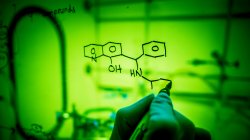In the chemical industry, green chemistry represents a major paradigm shift that focuses on environmental protection at the design stage of product and manufacturing processes. It is an innovative way to deal with chemicals before they become hazards, with the goal of making chemicals and products benign by design. In the academic world, green chemistry means focusing on recycling chemicals, or reducing the use of toxic chemicals in our programs and by finding creative ways to minimize the human and environmental impact without stifling scientific progress.
The Department of Chemistry and Biochemistry and Montclair State University are dedicated to the 12 Principles of Green Chemistry as defined by the EPA on their website:
- Prevent waste
- Design chemical syntheses to prevent waste. Leave no waste to treat or clean up.
- Maximize atom economy
- Design syntheses so that the final product contains the maximum proportion of the starting materials. Waste few or no atoms.
- Design less hazardous chemical syntheses
- Design syntheses to use and generate substances with little or no toxicity to either humans or the environment.
- Design safer chemicals and products
- Design chemical products that are fully effective yet have little or no toxicity.
- Use safer solvents and reaction conditions
- Avoid using solvents, separation agents, or other auxiliary chemicals. If you must use these chemicals, use safer ones.
- Increase energy efficiency
- Run chemical reactions at room temperature and pressure whenever possible.
- Use renewable feedstocks
- Use starting materials (also known as feedstocks) that are renewable rather than depletable. The source of renewable feedstocks is often agricultural products or the wastes of other processes; the source of depletable feedstocks is often fossil fuels (petroleum, natural gas, or coal) or mining operations.
- Avoid chemical derivatives
- Avoid using blocking or protecting groups or any temporary modifications if possible. Derivatives use additional reagents and generate waste.
- Use catalysts, not stoichiometric reagents
- Minimize waste by using catalytic reactions. Catalysts are effective in small amounts and can carry out a single reaction many times. They are preferable to stoichiometric reagents, which are used in excess and carry out a reaction only once.
- Design chemicals and products to degrade after use
- Design chemical products to break down to innocuous substances after use so that they do not accumulate in the environment.
- Analyze in real time to prevent pollution
- Include in-process, real-time monitoring and control during syntheses to minimize or eliminate the formation of byproducts.
- Minimize the potential for accidents
- Design chemicals and their physical forms (solid, liquid, or gas) to minimize the potential for chemical accidents including explosions, fires, and releases to the environment.
Green chemistry represents a philosophy of chemistry as opposed to a sub-discipline of chemistry like organic or physical chemistry. The Department has introduced green chemistry in our teaching laboratories and our faculty subscribe to the principles of green chemistry in their research. We have introduced the philosophy into our curriculum and even teach Green Chemistry as a course, CHEM330.
